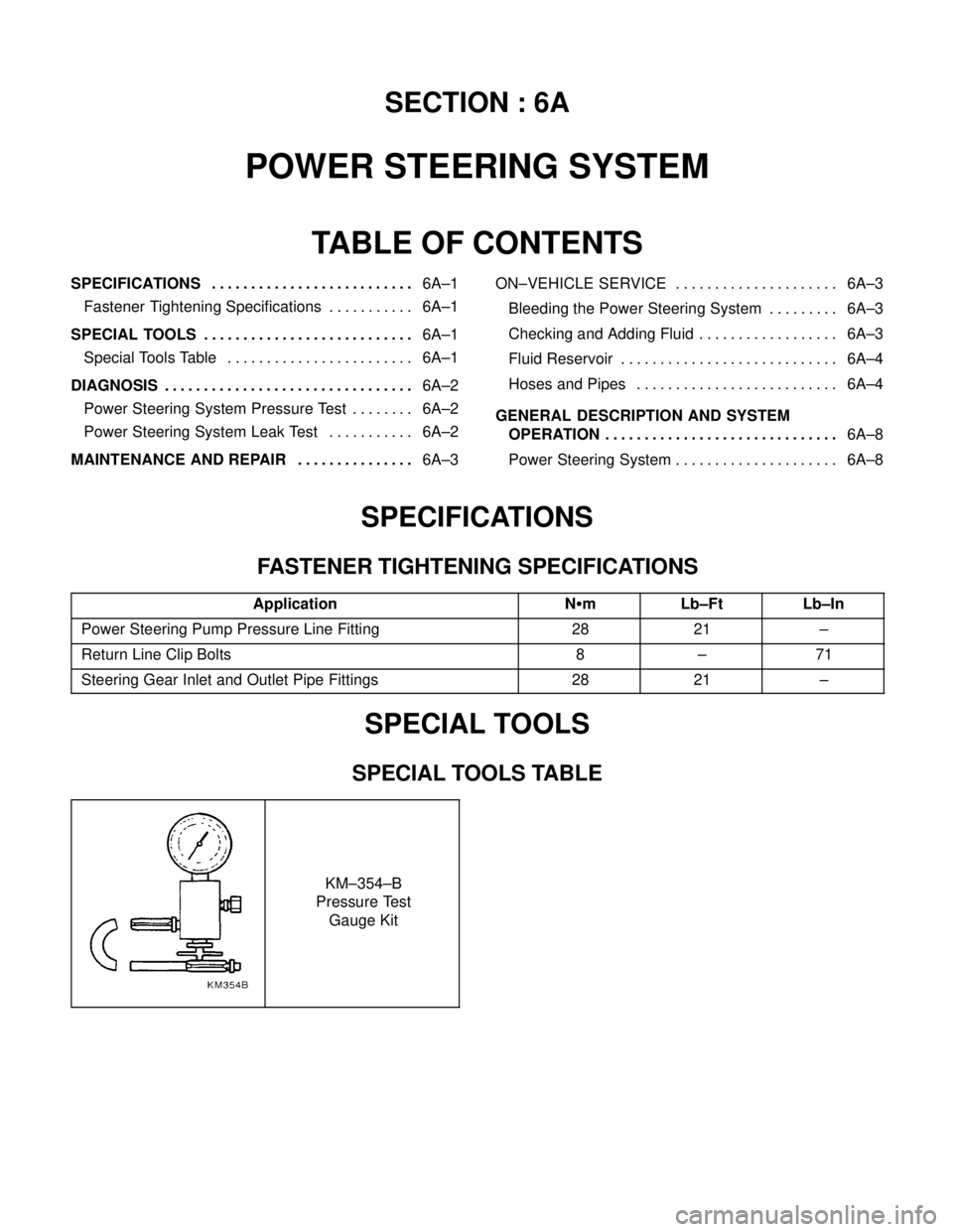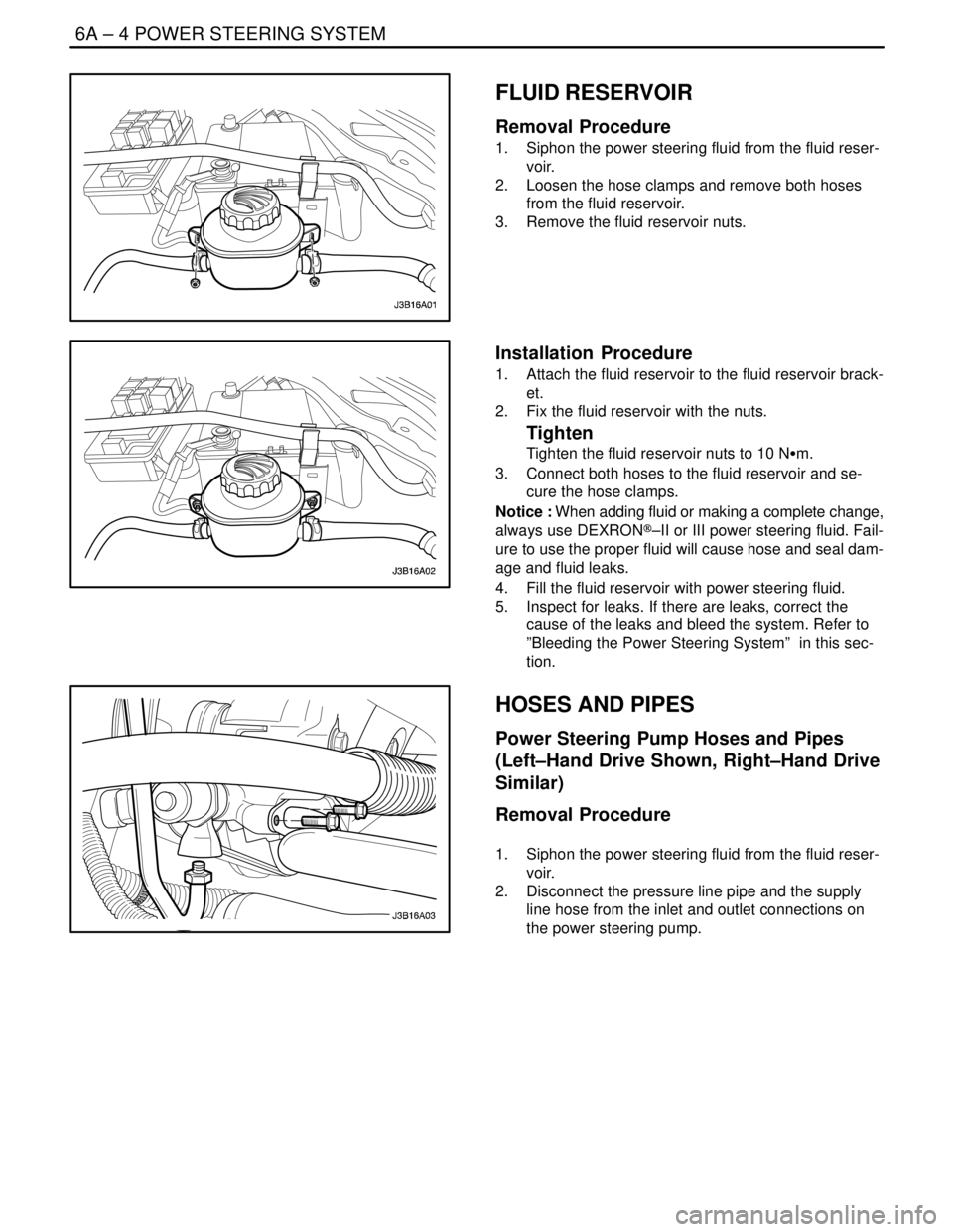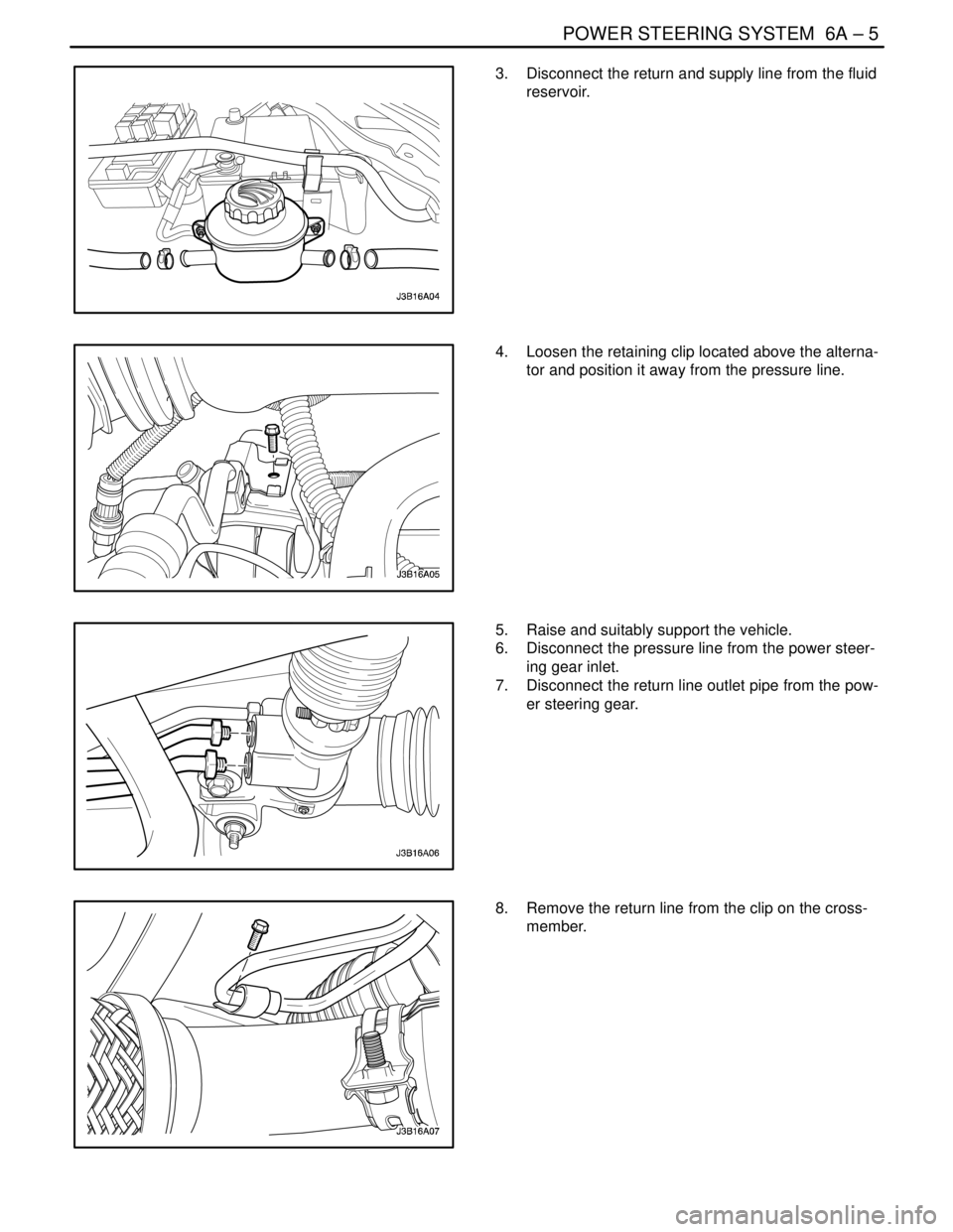2004 DAEWOO NUBIRA power steering fluid
[x] Cancel search: power steering fluidPage 1152 of 2643

ANTILOCK BRAKE SYSTEM 4F – 71
DAEWOO V–121 BL4
TIRES AND ABS/EBD
Replacement Tires
Tire size is important for proper performance of the ABS
system. Replacement tires should be the same size, load
range, and construction as the original tires. Replace tires
in axle sets and only with tires of the same tire perfor-
mance criteria (TPC) specification number. Use of any
other size or type may seriously affect the ABS operation.
TIRES AND ABS/EBD
Notice : There is no serviceable or removable EEPROM.
The EBCM must be replaced as an assembly.
The EBCM is attached to the hydraulic unit in the engine
compartment. The controlling element of ABS 5.3 is a mi-
croprocessor–based EBCM. Inputs to the system include
the four wheel speed sensors, the stoplamp switch, the
ignition switch, and the unswitched battery voltage. There
is an output to a bi–directional serial data link, located in
pin K of Data Link Connector (DLC) for service diagnostic
tools and assembly plant testing.
The EBCM monitors the speed of each wheel. If any wheel
begins to approach lockup and the brake switch is closed
(brake pedal depressed), the EBCM controls the sole-
noids to reduce brake pressure to the wheel approaching
lockup. Once the wheel regains traction, brake pressure
is increased until the wheel again begins to approach lock-
up. This cycle repeats until either the vehicle comes to a
stop, the brake pedal is released, or no wheels approach
lockup.
Additionally, the EBCM monitors itself, each input (except
the serial data link), and each output for proper operation.
If it detects any system malfunction, the EBCM will store
a DTC in nonvolatile memory (EEPROM) (DTCs will not
disappear if the battery is disconnected). Refer to ”Self
Diagnostics” in this section for more detailed information.
FRONT WHEEL SPEED SENSOR
The front wheel speed sensors are of a variable reluctance
type. Each sensor is attached to the steering knuckle,
close to a toothed ring. The result, as teeth pass by the
sensor, is an AC voltage with a frequency proportional to
the speed of the wheel. The magnitude of the voltage and
frequency increase with increasing speed. The sensor is
not repairable, nor is the air gap adjustable.
FRONT WHEEL SPEED SENSOR
RINGS
The toothed ring mentioned above is pressed onto the
wheel–side (outer) constant velocity joint. Each ring con-
tains 47 equally spaced teeth. Exercise care during ser-
vice procedures to avoid prying or contacting this ring. Ex-cessive contact may cause damage to one or more teeth.
If the ring is damaged, the wheel–side constant velocity
joint must be replaced.
REAR WHEEL SPEED SENSOR AND
RINGS
The rear wheel speed sensors operate in the same man-
ner as the front wheel speed sensors. They incorporate a
length of flexible harness with the connector attached to
the end of the harness. The rear wheel speed rings are in-
corporated into the hub assemblies and cannot be re-
placed separately, but require replacement of the rear
hub/bearing assembly.
VALUE RELAY AND PUMP MOTOR
RELAY
The valve relay and the motor pump relay are located in-
side the electronic brake control module (EBCM) and are
not replaceable. If one should fail, replace the EBCM.
WIRING HARNESS
The wiring harness is the mechanism by which the elec-
tronic brake control module (EBCM) is electrically con-
nected to power and to ground, to the wheel speed sen-
sors, the fuses, the switches, the indicators, and the serial
communications port. The components, considered part
of the wiring harness, are the wires that provide electrical
interconnection, and connectors (terminals, pins, con-
tacts, or lugs) that provide an electrical/mechanical inter-
face from the wire to a system component.
INDICATORS
The electronic brake control module (EBCM) continuously
monitors itself and the other ABS components. If the
EBCM detects a problem with the system, the amber ABS
indicator will light continuously to alert the driver to the
problem. An illuminated ABS indicator indicates that the
ABS system has detected a problem that affects the op-
eration of ABS. No antilock braking will be available. Nor-
mal, non–antilock brake performance will remain. In order
to regain ABS braking ability, the ABS must be serviced.
The red BRAKE indicator will be illuminated when the sys-
tem detects a low brake fluid level in the master cylinder
or when the parking brake switch is closed (the parking
brake is engaged) or EBD system is diabled.
WARNING : EBD INDICATOR LAMP WIRING IS CON-
NECTED TO THE PARKING BRAKE LAMP. IF THE
PARKING BRAKE LAMP IS TURNED ON WHEN YOU
DRIVING, CHECKING ON WHETHER THE PARKING
BRAKE LEVER IS ENAGED OR THE BRAKE FLUID
LEVEL IS LOW. IF THE SYSTEM HAS NO PROBLEM,
THE EBD SYSTEM IS WORKING IMPROPERLY. THE
EBD SYSTEM MUST BE SERVICED.
Page 1163 of 2643

ELECTRICAL WIRING DIAGRAMSW5–3
4. ECM (ENGINE CONTROL MODULE) : SIRIUS D4 5–34. . . . . . . . . . . . . . . . . . . . . . . . . . . . . . . . . . . . . . . . . . . . . . . . . .
1) BATTERY POWER SUPPLY, GROUND, EI SYSTEM & CKP SENSOR CIRCUIT 5–34. . . . . . . . . . . . . . . . . . . . .
2) FUEL PUMP, INJECTOR, FUEL CONNECTOR & CMP SENSOR CIRCUIT 5–36. . . . . . . . . . . . . . . . . . . . . . . . .
3) MTIA, SENSOR(ECT, KNOCK, IAT, MAP, ACP & HO2S) & POWER STEERING PRESSURE SWITCH
CIRCUIT : EOBD5–38 . . . . . . . . . . . . . . . . . . . . . . . . . . . . . . . . . . . . . . . . . . . . . . . . . . . . . . . . . . . . . . . . . . . . . . . . . . . . . . . .
4) MTIA, SENSOR(ECT, KNOCK, IAT, MAP, ACP & O2) & POWER STEERING PRESSURE SWITCH
CIRCUIT : NON EOBD5–40 . . . . . . . . . . . . . . . . . . . . . . . . . . . . . . . . . . . . . . . . . . . . . . . . . . . . . . . . . . . . . . . . . . . . . . . . . . .
5) EEGR VALVE, VR SENSOR, CLUSTER & FUEL PUMP CIRCUIT : EOBD 5–42. . . . . . . . . . . . . . . . . . . . . . . . . .
6) EGR VALVE, CLUSTER & FUEL PUMP CIRCUIT: NON EOBD 5–44. . . . . . . . . . . . . . . . . . . . . . . . . . . . . . . . . . . .
7) EVAP CANISTER PURGE SOLENOID, VGIS, CLUSTER, VSS, TCM & RON SWITCH CIRCUIT 5–46. . . . . . .
8) DLC, MIL LAMP & IMMOBILIZER CONTROL CIRCUIT 5–48. . . . . . . . . . . . . . . . . . . . . . . . . . . . . . . . . . . . . . . . . . .
5. TCM (TRANSMISSION CONTROL MODULE) : MR–140/HV–240 5–50. . . . . . . . . . . . . . . . . . . . . . . . . . . . . . . . . . . . .
1) POWER SUPPLY, GROUND, PNP SWITCH, BRAKE SWITCH & SOLENOID VALVE CIRCUIT 5–50. . . . . . . .
2) SENSOR(INPUT SPEED,OUTPUT SPEED, TRANSMISSION FLUID TEMP.), CLUSTER, DLC, ECM &
HOLD MODE SWITCH CIRCUIT5–52 . . . . . . . . . . . . . . . . . . . . . . . . . . . . . . . . . . . . . . . . . . . . . . . . . . . . . . . . . . . . . . . . . .
3) PNP SWITCH & CLUSTER CIRCUIT 5–54. . . . . . . . . . . . . . . . . . . . . . . . . . . . . . . . . . . . . . . . . . . . . . . . . . . . . . . . . . .
6. TCM (TRANSMISSION CONTROL MODULE) : SIRIUS D4 5–56. . . . . . . . . . . . . . . . . . . . . . . . . . . . . . . . . . . . . . . . . .
1) POWER SUPPLY, GROUND, PNP SWITCH, CLUSTER & ECM CIRCUIT : NOTCH BACK 5–56. . . . . . . . . . . .
2) POWER SUPPLY, GROUND, PNP SWITCH, CLUSTER & ECM CIRCUIT : HATCH BACK 5–58. . . . . . . . . . . .
3) BRAKE SWITCH, BTSI SOLENOID, ISS SENSOR & TRANSAXLE CIRCUIT 5–60. . . . . . . . . . . . . . . . . . . . . . . .
4) HOLD MODE SWITCH, VSS & DLC CIRCUIT 5–62. . . . . . . . . . . . . . . . . . . . . . . . . . . . . . . . . . . . . . . . . . . . . . . . . . .
7. AIR CONDITIONER5–64 . . . . . . . . . . . . . . . . . . . . . . . . . . . . . . . . . . . . . . . . . . . . . . . . . . . . . . . . . . . . . . . . . . . . . . . . . . . . .
1) AIR CONDITIONER CONTROL SWITCH, BLOWER MOTOR RESISTER & BLOWER MOTOR
CIRCUIT5–64 . . . . . . . . . . . . . . . . . . . . . . . . . . . . . . . . . . . . . . . . . . . . . . . . . . . . . . . . . . . . . . . . . . . . . . . . . . . . . . . . . . . . . . . .
2) AIR CONDITIONER CONTROL, INTAKE MOTOR SWITCH & AIR CONDITIONER COMPRESSOR
CIRCUIT5–66 . . . . . . . . . . . . . . . . . . . . . . . . . . . . . . . . . . . . . . . . . . . . . . . . . . . . . . . . . . . . . . . . . . . . . . . . . . . . . . . . . . . . . . . .
Page 1588 of 2643

ZF 4 HP 16 AUTOMATIC TRANSAXLE 5A1 – 239
DAEWOO V–121 BL4
S Excessive transaxle fluid leaking into the connector,
wicking up into the external wiring harness, and
degrading the wire insulation.
S Water/moisture intrusion in the connector.
S Low pin retention in the external connector from
excessive connection and disconnection of the wir-
ing connector assembly.
S Pin corrosion from contamination.
S Broken/cracked connector assembly.
S Points to remember when working with transaxle
wiring connector assembly.
S To remove the connector, squeeze the two tabs
towards each other and pull straight up (refer to
illustration).Carefully limit twisting or wiggling the connector during re-
moval. Bent pins can occur.
DO NOT pry the connector off with a screwdriver or other
tool.
To reinstall the external wiring connector, first orient the
pins by lining up arrows on each half of the connector.
Push the connector straight down into the transaxle with-
out twisting or angling the mating parts.
The connector should click into place with a positive feel
and/or noise.
Transaxle Control Module (TCM)
The transaxle control module (TCM) is an electronic de-
vice which monitors inputs to control various transaxle
functions including shift quality and transaxle sensors,
switches, and components to process for use within its’
control program. Based on this input information, the TCM
controls various transaxle output functions and devices.
Data Link Connector (DLC)
The data link connector (DLC) is a multiple cavity connec-
tor. The DLC provides the means to access serial data
from the TCM to aid in powertrain diagnosis. The DLC al-
lows the technician to use a scan tool to monitor various
systems and display diagnostic trouble codes (DTCs).
The DLC connector is located within the driver’s compart-
ment, directly below the steering column.
Page 1902 of 2643

SECTION : 6A
POWER STEERING SYSTEM
TABLE OF CONTENTS
SPECIFICATIONS6A–1 . . . . . . . . . . . . . . . . . . . . . . . . . .
Fastener Tightening Specifications 6A–1. . . . . . . . . . .
SPECIAL TOOLS6A–1 . . . . . . . . . . . . . . . . . . . . . . . . . . .
Special Tools Table 6A–1. . . . . . . . . . . . . . . . . . . . . . . .
DIAGNOSIS6A–2 . . . . . . . . . . . . . . . . . . . . . . . . . . . . . . . .
Power Steering System Pressure Test 6A–2. . . . . . . .
Power Steering System Leak Test 6A–2. . . . . . . . . . .
MAINTENANCE AND REPAIR6A–3 . . . . . . . . . . . . . . . ON–VEHICLE SERVICE 6A–3. . . . . . . . . . . . . . . . . . . . .
Bleeding the Power Steering System 6A–3. . . . . . . . .
Checking and Adding Fluid 6A–3. . . . . . . . . . . . . . . . . .
Fluid Reservoir 6A–4. . . . . . . . . . . . . . . . . . . . . . . . . . . .
Hoses and Pipes 6A–4. . . . . . . . . . . . . . . . . . . . . . . . . .
GENERAL DESCRIPTION AND SYSTEM
OPERATION6A–8 . . . . . . . . . . . . . . . . . . . . . . . . . . . . . .
Power Steering System 6A–8. . . . . . . . . . . . . . . . . . . . .
SPECIFICATIONS
FASTENER TIGHTENING SPECIFICATIONS
ApplicationNSmLb–FtLb–In
Power Steering Pump Pressure Line Fitting2821–
Return Line Clip Bolts8–71
Steering Gear Inlet and Outlet Pipe Fittings2821–
SPECIAL TOOLS
SPECIAL TOOLS TABLE
KM–354–B
Pressure Test
Gauge Kit
Page 1903 of 2643

6A – 2IPOWER STEERING SYSTEM
DAEWOO V–121 BL4
DIAGNOSIS
POWER STEERING SYSTEM
PRESSURE TEST
Tools Required
KM–354–B Pressure Test Gauge Kit
Check the fluid pressure as follows to determine whether
the trouble is in the pump or the gear unit.
Test Procedure
1. Check the power steering fluid level and the power
steering pump belt tension. Refer to ”Checking and
Adding Fluid” in this section and Section 6B, Power
Steering Pump.
2. Disconnect the high pressure line at the pump. Use
a small container to catch any fluid.
3. Connect the hose of the pressure test gauge kit
KM–354–B to the power steering pressure hose
from the power steering pump.
4. Place the gear selector lever in PARK (automatic
transaxle–equipped vehicles) or NEUTRAL (manual
transaxle–equipped vehicles). Set the parking
brake.
5. Open the gauge valve fully.
6. Start the engine and let it idle.
7. Turn the steering wheel from lock to lock several
times to warm the fluid to operating temperature.
8. Increase the engine speed to 1,500 rpm.
Notice : The power steering pump could be damaged if
the valve is fully closed for more than 5 seconds.
9. Close the gauge valve fully, and read the pressure.
The pump pressure with the valve closed should be
between 8,330 kPa to 8,820 kPa (1,208 psi to
1,279 psi). With electronic variable orifice, the pres-
sure should be between 8,500 kPa to 8,960 kPa
(1,233 psi to 1,299 psi).
10. Immediately open the gauge valve fully.
11. Turn the steering wheel all the way to the left and
the right. If the pressure is within the specified lim-
its, the problem is not in the pump. Check the pow-
er steering gear for leaks.
POWER STEERING SYSTEM LEAK
TEST
General Procedure
Inspect the following:
S The fluid reservoir for overfill.
S Fluid for aeration and overflow.
S The hoses for loose connections.
S The torsion bar, stub shaft and adjuster seals for
leaks.
S The component sealing surfaces for damage.
Important : Verify the exact point of the leak. The point
from which the fluid is dripping is not necessarily the point
at which the system is leaking. When service is required,
clean the leak area upon disassembly, replace the leaking
seal, check the component sealing surfaces for damage
and reset the torque bolt to specifications, where required.
External Leak Check
The purpose of this procedure is to pinpoint the location of
the leak. In some cases, the leak can be easily located, but
seepage–type leaks may be harder to find. To locate seep-
age leaks, use the following method:
1. With the engine off, wipe dry the complete power
steering system.
2. Check the power steering fluid level in the pump’s
reservoir. Adjust the fluid level as necessary. Refer
to ”Checking and Adding Fluid” in this section.
Notice : Do not hold the steering wheel at a stop for any
length of time as this can damage the power steering
pump.
3. Start the engine. Turn the steering wheel counter-
clockwise and clockwise from stop to stop several
times.
4. Find the exact area of the leak and repair it.
Page 1904 of 2643

POWER STEERING SYSTEM 6A – 3
DAEWOO V–121 BL4
MAINTENANCE AND REPAIR
ON–VEHICLE SERVICE
BLEEDING THE POWER STEERING
SYSTEM
If the power steering hydraulic system has been serviced,
an accurate fluid level reading cannot be obtained until the
air is bled from the system. Follow these steps to bleed the
air from the system.
1. Turn the wheels all the way to the left and add the
power steering fluid to the MIN mark on the fluid
level indicator.
Notice : When adding fluid or making a complete fluid
change, always use DEXRON®–II or III power steering
fluid. Failure to use the proper fluid will cause hose and
seal damage and fluid leaks.
2. Start the engine. With the engine running at fast
idle, recheck the fluid level. If necessary, add fluid
to bring the level up to the MIN mark.
3. Bleed the system by turning the wheels from side to
side without reaching the stop at either end. Keep
the fluid level at the MIN mark. The air must be
eliminated from the fluid before normal steering ac-
tion can be obtained.
4. Return the wheels to the center position. Continue
running the engine for 2 to 3 minutes.
5. Road test the car to be sure the steering functions
normally and is free from noise.
6. Recheck the fluid level as described in steps 1 and
2. Make sure the fluid level is at the MAX mark af-
ter the system has stabilized at its normal operating
temperature. Add fluid as needed.
CHECKING AND ADDING FLUID
Notice : When adding fluid or making a complete fluid
change, always use DEXRON®–II or III power steering
fluid. Failure to use the proper fluid will cause hose and
seal damage and fluid leaks.
1. The power steering fluid level is indicated either by
marks on a see–through fluid reservoir or by marks
on a fluid level indicator on the fluid reservoir cap.
2. If the fluid is warmed up to 66°C (150°F), the fluid
level should be between the MAX and MIN marks.
Add fluid as needed.
3. If the fluid is cool, 21°C (70°F), the fluid level
should be at the MIN mark. Add fluid as needed.
Page 1905 of 2643

6A – 4IPOWER STEERING SYSTEM
DAEWOO V–121 BL4
FLUID RESERVOIR
Removal Procedure
1. Siphon the power steering fluid from the fluid reser-
voir.
2. Loosen the hose clamps and remove both hoses
from the fluid reservoir.
3. Remove the fluid reservoir nuts.
Installation Procedure
1. Attach the fluid reservoir to the fluid reservoir brack-
et.
2. Fix the fluid reservoir with the nuts.
Tighten
Tighten the fluid reservoir nuts to 10 NSm.
3. Connect both hoses to the fluid reservoir and se-
cure the hose clamps.
Notice : When adding fluid or making a complete change,
always use DEXRON®–II or III power steering fluid. Fail-
ure to use the proper fluid will cause hose and seal dam-
age and fluid leaks.
4. Fill the fluid reservoir with power steering fluid.
5. Inspect for leaks. If there are leaks, correct the
cause of the leaks and bleed the system. Refer to
”Bleeding the Power Steering System” in this sec-
tion.
HOSES AND PIPES
Power Steering Pump Hoses and Pipes
(Left–Hand Drive Shown, Right–Hand Drive
Similar)
Removal Procedure
1. Siphon the power steering fluid from the fluid reser-
voir.
2. Disconnect the pressure line pipe and the supply
line hose from the inlet and outlet connections on
the power steering pump.
Page 1906 of 2643

POWER STEERING SYSTEM 6A – 5
DAEWOO V–121 BL4
3. Disconnect the return and supply line from the fluid
reservoir.
4. Loosen the retaining clip located above the alterna-
tor and position it away from the pressure line.
5. Raise and suitably support the vehicle.
6. Disconnect the pressure line from the power steer-
ing gear inlet.
7. Disconnect the return line outlet pipe from the pow-
er steering gear.
8. Remove the return line from the clip on the cross-
member.